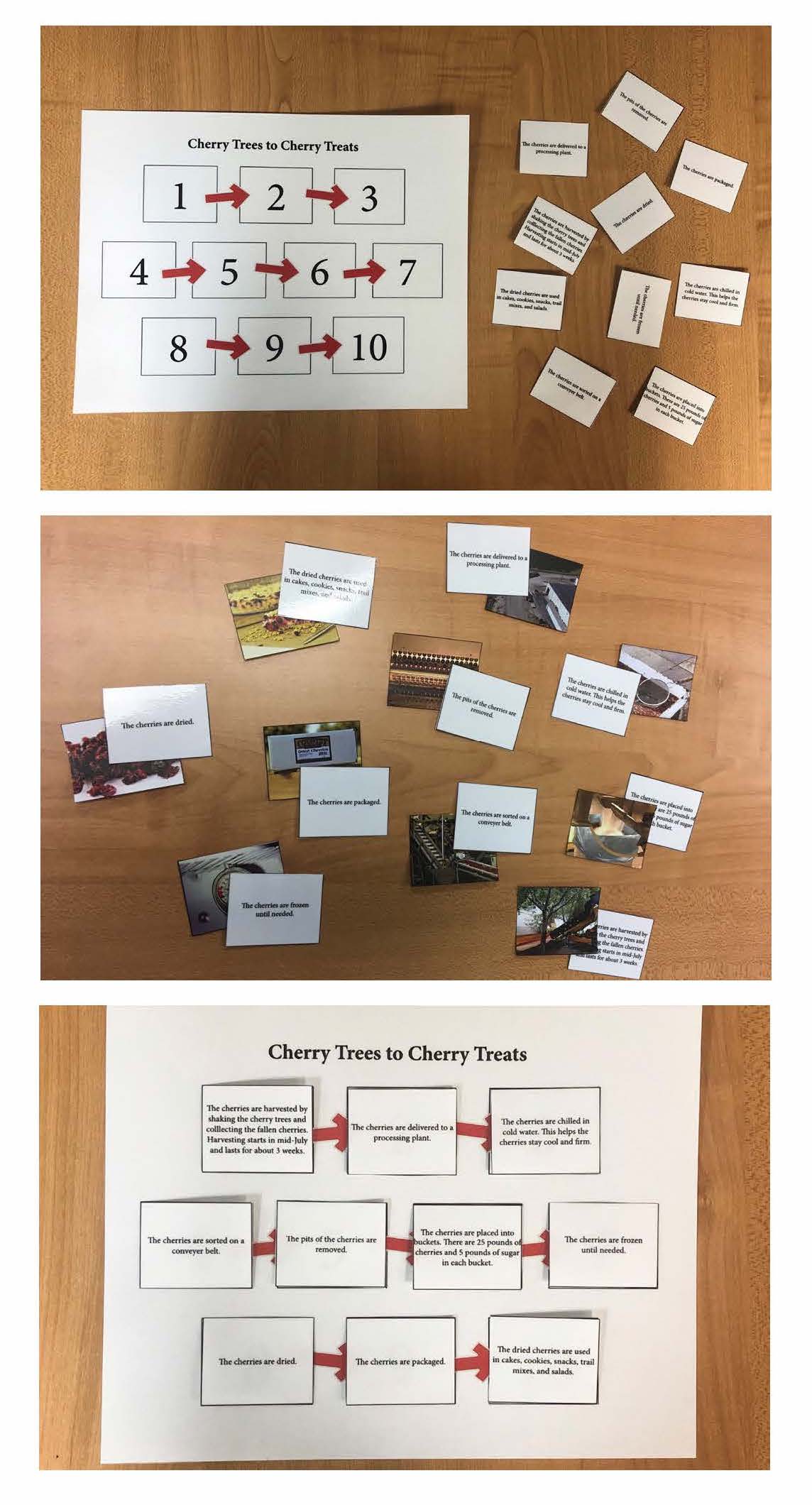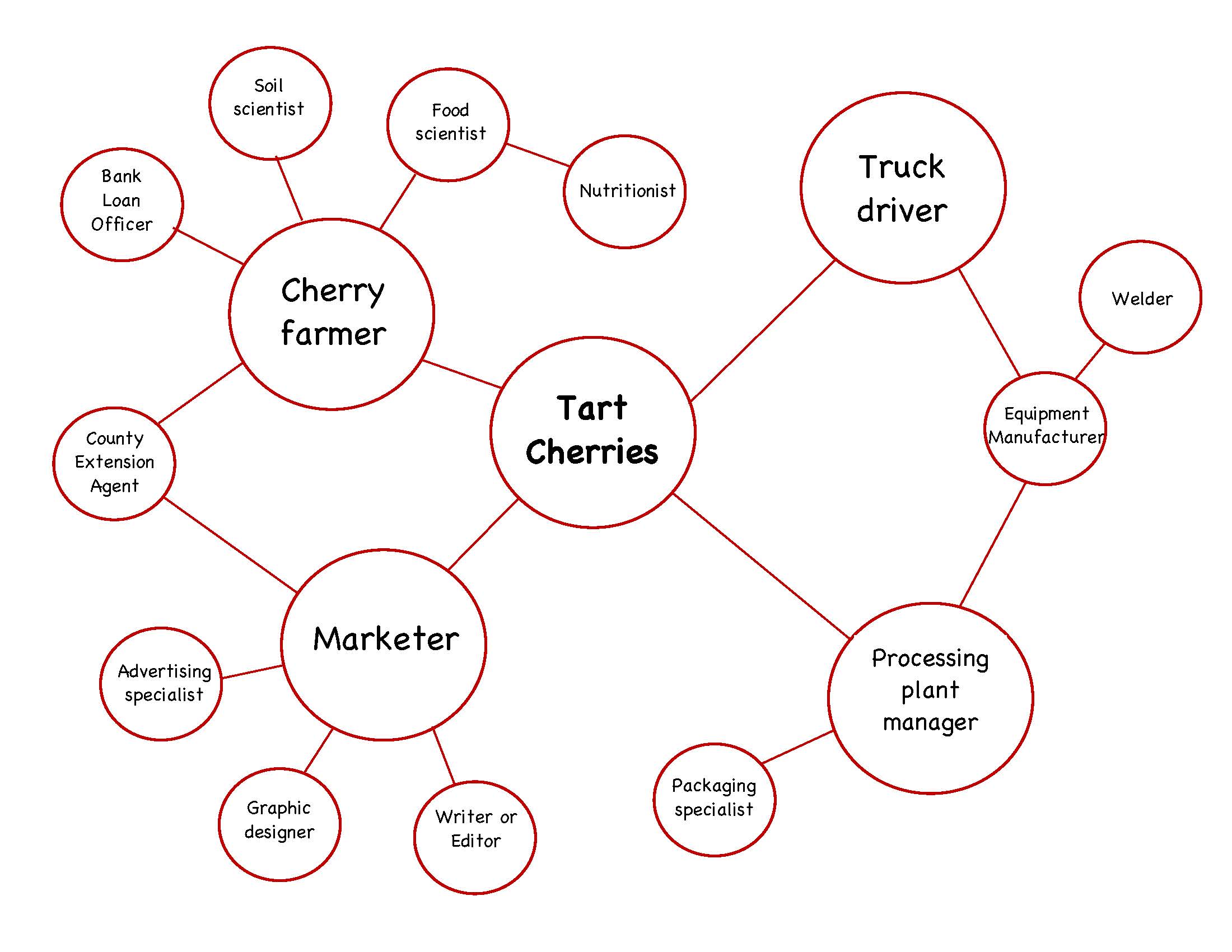 Relevancy and Engagement
dc.agclassroom.org
Relevancy and Engagement
dc.agclassroom.org
The TART Cherry on Top
Grade Level
Purpose
Students explore tart cherry production in the United States and explain why producers and consumers are needed in the cherry industry. Grades 3-5
Estimated Time
Materials Needed
Engage:
- How to Make a Cherry Pie and See the U.S.A. by Marjorie Priceman
Activity 1: Cherry Trees to Cherry Treats
- Cherry Trees to Cherry Treats handout, 1 per student pair
- Scissors, 1 per student pair
- Tart Cherry Harvest and Processing in Utah video
Activity 2: Cherry Career Clusters
- Blank sheet of paper, 1 per student pair
- Markers
- Whiteboard, poster, or large butcher paper
Activity 3: Cherry Marketing
- Blank sheet of paper, 1 per student
- Crayons, markers, and colored pencils
Vocabulary
consumer: a person who buys and uses goods and services
farm to fork : the various processes in the food chain from agricultural production to consumption
producer: a person or company that makes, grows, or supplies goods or services
superfood: a nutrient-rich food considered to be especially beneficial for health and well-being
Did You Know?
- Tart cherries are better than sweet cherries for recipes that require baking. That’s because tart cherries are more acidic; sweet cherries lose their flavor and shape when baked.1
- Research has shown that Montmorency cherries (and other tart cherries) help recovering muscles and arthritis pain, aid in heart health, and improve sleep quality.1
- You won’t find many fresh tart cherries in the grocery store; they are typically dried, frozen, or juiced. Tart cherries are most commonly used for baking, canning, drying, juicing, and jamming.2
Background Agricultural Connections
One of America's favorite pie flavors is cherry! Seventy-five percent of the tart cherries in the United States are produced in the cherry capital of the world—Michigan! Utah is second in the nation for tart cherry production followed by Washington.3 Typically, sweet cherries are eaten fresh, while tart (or sour) cherries are used for pies and other baked goods.
The average American consumes about one pound of tart cherries each year; however, consumption of tart cherries is steadily climbing due to the long list of health benefits. Tart cherries are a popular superfood rich in antioxidants which help with arthritis pain, anti-inflammation, muscle recovery, and heart health.
Like any agricultural product, tart cherry production requires a variety of careers to complete the farm to fork process. The tart cherry industry relies on numerous producers and consumers to grow, harvest, and market tart cherries. Tart cherry farmers are not only fruit producers, but consumers of other goods and services in the community as well. For example, loan officers at the bank assist cherry farmers with big purchases for the farm. Soil scientists ensure the soil in the orchard is suitable for cherry trees. Truck drivers haul the cherries from the orchard to the processing plant where the processing plant manager oversees the cherry processing. Once the cherries have been harvested and processed, marketing specialists work to promote cherry sales. Meanwhile, graphic designers are needed to create an appealing advertisement and unique logo for the cherry farm. The list of careers needed to produce tart cherries goes on and on!
Engage
- Read the book How to Make a Cherry Pie and See the U.S.A.

- Lead a discussion about the book with students. Point out that the story spends a significant amount of time talking about all of the tools needed to make a cherry pie, but not much time talking about the ingredients needed. Ask the students, "What ingredients are needed to make a cherry pie?"
- Explain to students that they are going to learn more about the most important ingredient in a cherry pie—cherries!
Explore and Explain
Activity 1: Cherry Trees to Cherry Treats
- Divide the students into pairs.

- Pass out the Cherry Trees to Cherry Treats handout (timeline, processing steps, and photos) to each pair.
- Ask students to cut out each of the steps in individual squares, as well as the photos. Leave the timeline with numbers intact.
- Instruct students to read through each of the cherry processing steps and match the correct photo with each step.
- Ask students to place each step and photo on the correct timeline number, indicating the order they think dried, tart cherries are processed. Allow students to discuss ideas with their partner and problem-solve. Consider asking the following questions to guide students as they guess the correct order.
- Would you remove the pits of the cherries before or after you freeze the cherries? Why or why not?
- Would chilling cherries in cold water come before or after the drying process?
- Why would you want firm cherries before removing the pits?
- Explain to the students that Michigan, Utah, and Washington are the top three states that produce tart cherries. Take a virtual field trip to a tart cherry orchard by viewing the video Tart Cherry Harvesting and Processing in Utah. As the video plays, have students follow along and correct their timelines, if needed.
- Step 1: The cherries are harvested by shaking the trees and collecting the fallen cherries. Harvesting starts in mid-July and lasts for about three weeks.
- Step 2: The cherries are delivered to a processing plant.
- Step 3: The cherries are chilled in cold water. This helps the cherries stay cool and firm.
- Step 4: The cherries are sorted on a conveyor belt.
- Step 5: The pits of the cherries are removed.
- Step 6: The cherries are placed into buckets. 25 pounds of cherries and 5 pounds of sugar.
- Step 7: The cherries are frozen until needed.
- Step 8: The cherries are dried.
- Step 9: The cherries are packaged.
- Step 10: The dried cherries are used in cakes, cookies, snacks, trail mixes, and salads.
- Consider bringing dried tart cherries to class to show students.
Activity 2: Cherry Career Clusters
- Explain to students that when tart cherries aren't dried, they can also be used for baking and cooking. This includes cherry pie fillings, cherry jams, frozen cherries, and even unique recipes such as cherry salsa.
- Ask students to brainstorm every person and career that helps produce and process tart cherry products.
- Pass out a blank piece of paper to each student.
- Instruct students to create a web or cluster with "tart cherries" written in the middle circle of the cluster. Individually, or in pairs, have students brainstorm all the careers that help get cherries from the farm to the table. Encourage students to think of every detail when it comes to farming, growing fruit, trucking, processing, packaging, marketing, etc. Refer to the Background Agricultural Connections section, if needed.
- Consider asking the following questions to guide students and promote critical thinking.
- Who helps the farmers when they need money to buy equipment?
- How do the cherries get put in packages or jars?
- Who designed the labels on the jars?
- How do cherries get from the farm to the processing plant or grocery store?
- Ask students to share their career clusters with the rest of the class.
- Draw one large tart cherry circle on the whiteboard and have each student add one circle/career. The goal is to have students create one large career cluster as a class that showcases a wide variety of jobs and careers.
- Discuss the different careers in a community that benefit the tart cherry industry.
- Ask students what the difference is between a producer and consumer as you study the career cluster on the whiteboard.
- Explain that producers make, grow, or supply goods and services. Consumers purchase those goods and services. (Students might also associate consuming with eating.)
- Ask students to identify the producers and consumers in the career cluster on the whiteboard. Ask students to put a star by all the producers and an arrow by all the consumers. Consider asking the following questions about specific careers on the whiteboard:
- Can someone be a producer and a consumer?
- Who is the consumer of ________'s services?
- How is the cherry farmer a producer and a consumer?
- What services will the _______ produce?
- Explain to students that industries, like the cherry industry, rely on producers and consumers working together in order to be successful.

Activity 3: Cherry Marketing
- Refer back to the agricultural careers discussed in Activity 2 with your students. Ask your students to brainstorm tasks involved in the marketing and advertising of a product. If it's not on your students' career cluster, take time to add it to the cluster on the whiteboard. Consider asking the following questions:
- If you're trying to sell a product, what kind of information would you want to include on a flyer or advertisement?
- What catches your attention with flyers and advertisements?
- Ask students to imagine they own a tart cherry farm. Their job is to design a flyer advertising their tart cherries that can be hung up around the community. Students' flyers should include the following components:
- Tart cherry business name
- Pictures of tart cherries
- A list of cherry products the company sells
- Encourage creativity and remind students to think back to the discussion about what makes a successful advertisement. Allow students to share their advertisements with the rest of the class.
- Have students vote for the top cherry advertisement in the class, if desired.
Elaborate
-
View the videos Michigan Cherries: Shaken, Not Stirred and Michigan Cherry Harvest: Shake it Up! to learn more about cherry production, harvesting, and processing.
-
Use the following directions to make a cherry pie in a slow cooker.4
- Spray a slow cooker with a non-stick cooking spray.
- Pour two 21-ounce cans of cherry pie filling into the slow cooker.
- Pour one box of yellow cake mix on top of the cherries (don't mix).
- Drizzle a 1/2 cup of melted butter on top.
- Cook on high for 2-3 hours.
- Serve warm (with ice cream, if desired).
-
Watch this Q&A video about cherries from Rowley's Red Barn located in Santaquin, Utah. To engage students, pause the video after each question before it is answered and have students guess the correct answer. This can be done as a class discussion or students can write their guesses on a personal whiteboard.
Evaluate
After conducting these activities, review and summarize the following key concepts:
- Sweet cherries are typically eaten fresh and tart cherries are used for pies and other baked goods.
- A producer makes, grows, or supplies goods or services and a consumer purchases goods and services.
- Like any agricultural product, tart cherry production requires a variety of careers to grow, harvest, and market the products.
Sources
- https://www.rowleysredbarn.com/fresh-utah-cherries/morello/
- http://www.choosecherries.com/tart-cherries-101/
- https://www.agmrc.org/commodities-products/fruits/cherries
- https://crockpotladies.com/recipe/crockpot-cherry-dump-cake/